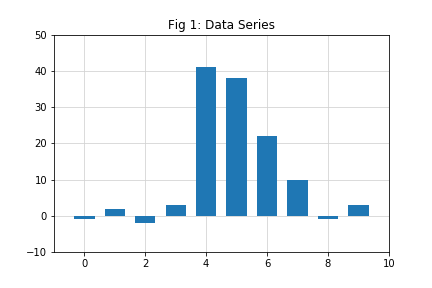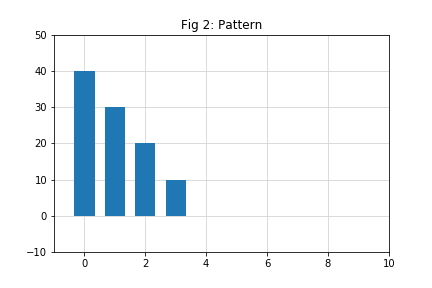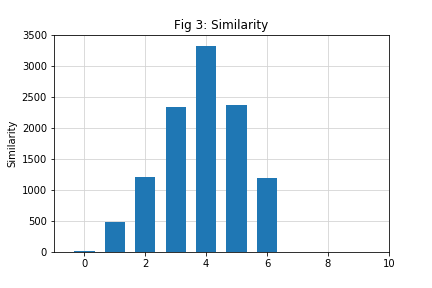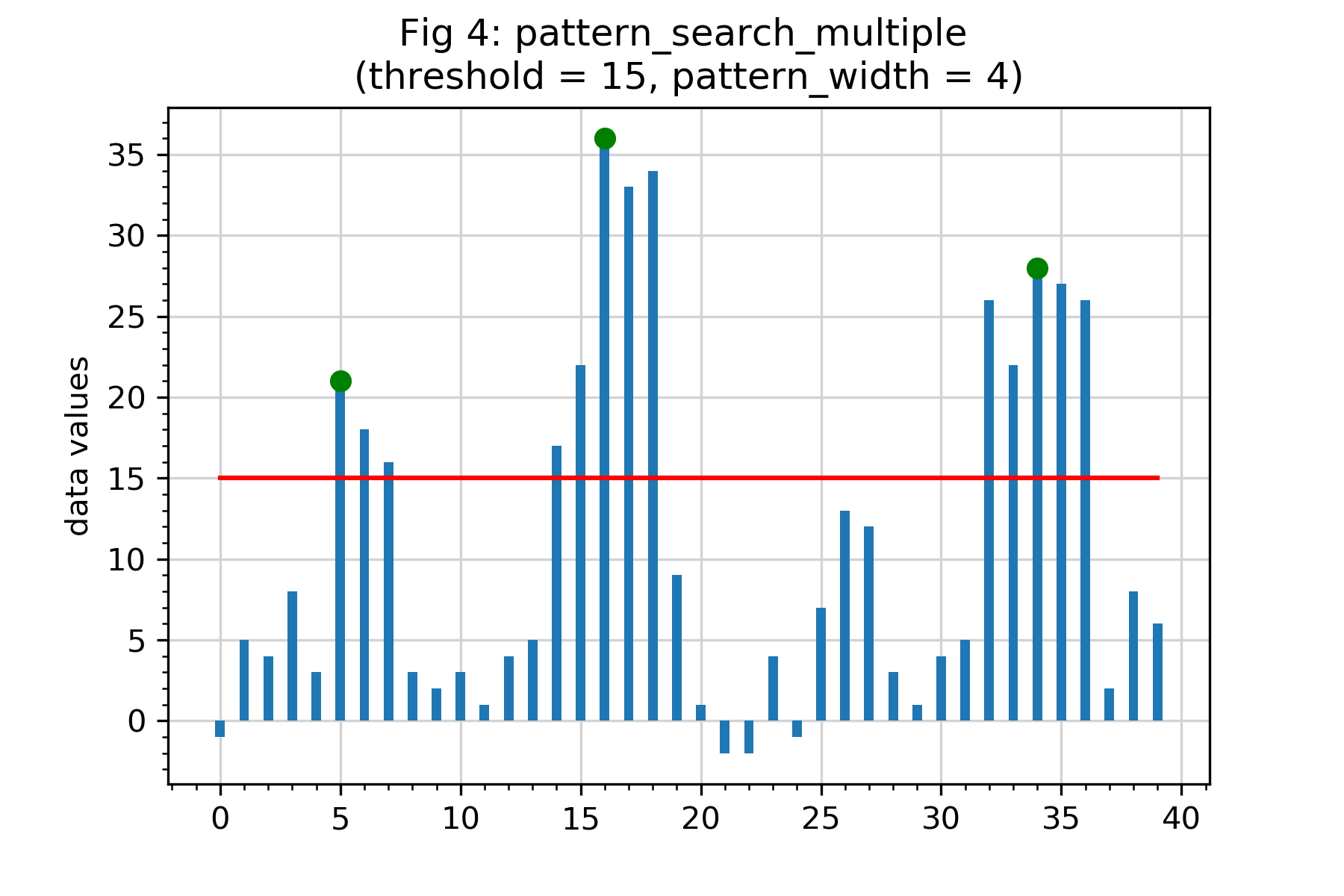ENGG1811 Assignment 1: Pattern detection
- Due date: 5pm, Wednesday of Week-07 .
- Late Penalty: Late submissions will be penalised at the rate of 10% per day (including weekends).
The penalty applies to the maximum available mark. For example, if you submit 2 days late,
maximum available marks is 80% of the assignment marks.
- Submissions will not be accepted after 9am Monday of Week-08.
Change Log
- [02:45pm Wed 08/July] Instructions on how to submit your assignment are now available in the
Submission section below.
- [02:55pm Tue 07/July] For the fourth function, you need to return one of the three outcomes specified in the specificaions. I have now modified the comments in the file "pattern_search_multiple.py" and make them consistent
with the specs.
- [6:20pm Tue 23/Jun] Please note that you must not use numpy library for this assignment.
The pattern detection problem
In this assignment, your goal is to write a python program to
determine whether a given pattern appears in a data series, and if so,
where it is located in the data series. This type of problems is very
common in many disciplines, including computer science, engineering,
medicine and science. There are many different types of pattern detection
problems, the setting of this assignment is similar to that used in
radars. A radar transmits a pulse of a specific shape and waits for
a pulse of similar shape to return, in order to determine the position of
an object. The method described below is known as matched filtering and is
widely used in communication systems. This means your mobile phones
perform the same type of calculations that you will be programming below!
Learning objectives
By completing this assignment, you will learn:
- To apply programming concepts of variable declaration, constant
declaration, assignment, selection and iteration (for loop).
- To translate an algorithm described in a natural language to a
computer language.
- To organize programs into smaller modules by using functions.
- To use good program style including comments, meaning variable names and others.
- To get a practice on software development, which includes incremental
development, testing and debugging.
Algorithm for locating a pattern in a
data series
The goal is to detect whether a certain pattern appears in the data
series. In the following example, the pattern to be detected is a sequence of 4 numbers (see Fig 2);
and the data series contains 10 data points (see Fig 1).
data_series = [-1, 2, -2, 3, 41, 38, 22, 10, -1, 3]
pattern = [40, 30, 20, 10]


If you compare these two figures, you can see that this pattern appears
between 5th (at index 4) to 8th (at index 7) data points of the data series. Note that it is not an
exact match, but a fairly close one. Now you can spot the pattern using
your eyes, let us see how an algorithm can do it.
Since the given pattern has 4 data points, we will take a segment of 4
consecutive data points from the data series at a time and compute a
similarity measure. The similarity measure should have the property
that if a segment of the data series is similar to the given pattern, then
the similarity measure of that segment is large, and vice versa. Hence, if
we can compute the similarity measures of all possible segments, then we
can identify the segment that is most similar to the given pattern. We
will now provide more details.
The algorithm begins with computing the similarity measure between the
given pattern and the first segment,
which is formed by the first 4 data points of the data series. In terms of
the two lists above, the similarity measure for the first segment is:
data_series[0]*pattern[0] + data_series[1]*pattern[1] + data_series[2]*pattern[2] + data_series[3]*pattern[3]
After this, we compute the similarity measure between the given pattern
and the second segment, which is
formed by the second to fifth data points of the data series. For the above example,
the similarity measure for this segment is:
data_series[1]*pattern[0] + data_series[2]*pattern[1] + data_series[3]*pattern[2] + data_series[4]*pattern[3]
We then do the same with the segment formed by the third to sixth data
points (the third segment), giving a similarity measure equals to:
data_series[2]*pattern[0] + data_series[3]*pattern[1] + data_series[4]*pattern[2] + data_series[5]*pattern[3]
We repeat this until we have computed the similarity measure
for the last possible segment, which is formed by the 7th to 10th data
points. The following is the similarity list for the above example and a plot:
similarity = [10, 490, 1210, 2330, 3320, 2370, 1190]

We need to consider the following cases.
Case 1:
It is possible that the given data series is shorter than the given pattern, in this case, we return "Insufficient data".
Case 2: All the similarity
measures are (strictly) less than the given threshold value. This
means none of the segments is similar to the given pattern. In this case,
we say the pattern is not present in the data series and return
"Not detected". This is not the case for this example.
Case 3: At least one similarity
measure is greater than or equal to the given threshold value. This is the
case for this example. The similarity measure plot above shows that the
fifth similarity measure is the largest. You can work out that the fifth
similarity measure is computed by using the segment formed by the fifth (index 4) to
eighth (index 7) data points of the data series. This procedure is therefore telling
us that the segment consisting of fifth to eighth data points is most
similar to the given pattern. Indeed this is what we had found by using
visual inspection earlier. We will identify the location of the pattern by
using the first index of the segment that has the highest similarity
measure.
- function pattern_search_max (described below): we return
the index of the highest similarity measure that is also greater than or equal to the given threshold value.
In Fig 3, the index of the highest similarity measure is 4.
- function pattern_search_multiple (described below):
Consider the following definition of overlapping indices,
We say two indices are overlapping if the distance between them is
less than the width of the pattern (4 in the above example).
The function 'pattern_search_multiple' returns a list of non overlapping indices that are greater
than or equal to the given threshold value, and that satisfy the following criteria:
- an index is not selected if the value at the index is less than a value at one of it's overlapping indices.
- an index is not selected if it is overlapping with first or last index.
In the following example, selected indices are marked with green circles. Here, index 6 is not selected because the value at index 5 (distance of 1) is greater than the value at index 6. Similarly index 32 is not selected because the value at index 34 (distance 2) is higher.
The example in Fig 4 will return the list [5, 16, 34].
There are many different approaches to calculate similarity measures between data segments and a pattern,
above we have discussed just one of them!
Therefore, a given data series representing similarity measures may or may not have clearly defined 'pyramid'
patterns as shown in Fig 3.
For example, there are no clearly defined 'pyramid' patterns in Fig 4.

This completes the description of the tasks
Implementation requirements
You need to implement the following four functions, each in a separate file (provided).
You need to submit these four files, each containing one function you implement.
1. def calculate_similarity(data_segment, pattern):
- The aim of this function is to calculate the similarity measure between
one data segment and the pattern.
- The first parameter 'data_segment' is a list of (float) values, and the second
parameter 'pattern' is also a list of (float) values. The function calculates the
similarity measure between the given data segment and pattern
and returns the calculated similarity value (float), as described earlier in this assigment.
The function returns "Error" if 'data_segment' and 'pattern' have different lengths.
- This function can be tested using the file 'test_calculate_similarity.py'.
2. def calculate_similarity_list(data_series, pattern):
- The aim of this function is to calculate the similarity measures between
all possible data segments and the pattern.
- The first parameter 'data_series' is a list of (float) values, and the second
parameter 'pattern' is also a list of (float) values. The function calculates the
similarity measures, using the above function 'calculate_similarity', of all possible data segments in a sequence, and returns
the list of calculated similarity values.
- This function can be tested using the file 'test_calculate_similarity_list.py'.
3. def pattern_search_max(data_series, pattern, threshold):
- The three possible outcomes are "Insufficient data", "Not detected" and
the location of the pattern if the pattern is found in the data series.
Here, the location of the pattern refers to the index of the highest
similarity measure that is also greater than or equal to the given threshold value.
- The first parameter 'data_series' is a list of (float) values, the second
parameter 'pattern' is a list of (float) values, and
the third parameter 'threshold' is a (float) value.
In this function, you need to use the function 'calculate_similarity_list'.
- This function can be tested using the file 'test_pattern_search_max.py'.
4. def pattern_search_multiple(data_series, pattern_width, threshold):
- The three possible outcomes are "Insufficient data", "Not detected" and
a list of non overlapping indices that are greater
than or equal to the given threshold value, and that satisfy the following criteria:
- an index is not selected if the value at the index is less than a value at one of it's overlapping indices.
- an index is not selected if it is overlapping with first or last index.
We say two indices are overlapping if the distance between them is
less than the width of the pattern.
- The first parameter 'data_series' is a list of (float) values, the second
parameter 'pattern_width' is a (float) value, and
the third parameter 'threshold' is a (float) value.
- This function can be tested using the file 'test_pattern_search_multiple.py'.
Please note that you must not use numpy library for this assignment.
Getting Started
- Download the zip file ass1_prelim.zip, and unzip it.
This will create the directory (folder) named 'ass1_prelim'.
- Rename/move the directory (folder) you just created named 'ass1_prelim' to 'ass1'.
The name is different to avoid possibly overwriting your work if you
were to download the 'ass1_prelim.zip' file again later.
- First browse through all the files provided, and importantly read comments in the files.
- Do not try to implement too much at once, just one function at a time
and test that it is working before moving on.
- Start implementing the first function, properly test it using the given testing file, and once you are happy, move on to the the second function, and so on.
- Please do not use 'print' or 'input'
statements. We won't be able to assess your program properly if you do.
Remember, all the required values are part of the parameters, and
your function needs to return the required answer. Do not 'print' your answers.
Testing
Test your functions thoroughly before submission. You can use the
provided python programs (files like 'test_calculate_similarity.py', 'test_pattern_search_max.py',
'test_pattern_search_multiple.py', etc.) to test your functions.
Please note that the tests
provided in these files cover only basic scenarios (cases), you need to think about other possible cases, modify the files accordingly and test your functions. For example,
you need to add cases to test for "Insufficient data" and "Not detected" scenarios.
Submission
You need to submit the following four files. Do not submit any other files. For example, you do not need to submit your modified test files.
- calculate_similarity.py
- calculate_similarity_list.py
- pattern_search_max.py
- pattern_search_multiple.py
To Submit this assignment, go to the
Submission page and click the tab named "Make Submission".
Assessment Criteria
We will test your program thoroughly
and objectively. This assignment will be marked out of 25 where 20 marks
are for correctness and 5 marks are for style.
Correctness
The 20 marks for correctness are awarded according to these criteria.
| Criteria |
Nominal marks |
| Function calculate_similarity |
4 |
| Function calculate_similarity_list |
4 |
| Function pattern_search_max |
3 |
| Function pattern_search_multiple |
5 |
| Case "Insufficient data" |
2 |
| Case "Not detected" |
2 |
Style
Five (5) marks are awarded by your tutor for style and complexity of your solution.
The style assessment includes the following, in no particular order:
- Use of meaningful variable names where applicable
- Use of sensible comments to explain what you're doing
- Use of docstring for documentation to identify purpose, author, date , data dictionary,
parameters, return value(s) and program description at the top of the file
Assignment Originality
You are reminded that work submitted for assessment must be your own.
It's OK to discuss approaches to solutions with other students, and to get
help from tutors and consultants, but you must write the python code
yourself. Sophisticated software is used to identify submissions that are
unreasonably similar, and marks will be reduced or removed in such cases.
Further Information
- Additional Help Sessions will be available for this assignment during week-05 to week-07.
- Use the forum to ask
general questions about the assignment, but take specific ones to Help Sessions.
- You can ask your tutor during your lab time any queries you may have regarding this assignment.
- Keep an eye on the class webpage notice board for updates and responses.



